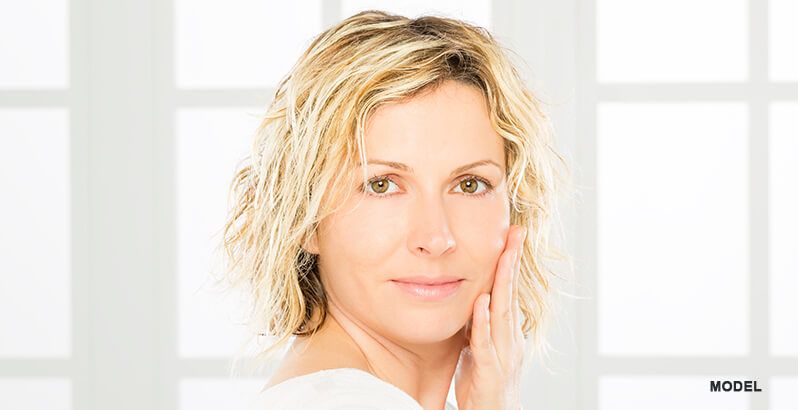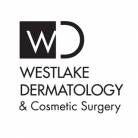Chest Wrinkles: Causes, Prevention and Treatment

Although anti-aging techniques tend to focus on the face and neck, the upper chest, otherwise known as the décolleté, is a prominent area for which wrinkles can manifest. As chest wrinkles can detract from a youthful face and neck, it is important to protect the décolleté from extrinsic causes of wrinkling and also be aware of available treatment options for wrinkles in this area.
What are Chest Wrinkles?
Chest wrinkles, also called cleavage rhytides, sleep creases, or décolletage wrinkles, are skin creases that appear on the upper chest between the neck and upper abdomen. Chest wrinkles start out as dynamic lines or creases that result from certain body movements and positions such as sleeping on your side. With aging, these dynamic lines and creases gradually lose their ability to resolve after body movements and can eventually become static and visible at rest. Chest wrinkles can vary in severity from superficial fine lines to deeply furrowed creases, which become more challenging to treat.
What Causes Chest Wrinkles?
Wrinkles result from the overall decline in elastin and collagen, which are proteins responsible for providing the skin with its structure, firmness, and elasticity. Several factors contribute to this decline in elastin and collagen.
Genetics
If chest wrinkles run in your family, you are more likely to get them. The bottom line is that genetics plays a strong role in determining not only your baseline production of collagen and elastin but also the breakdown rate of these structural proteins.
Natural Aging
No matter what your genetics predetermines, the production of collagen and elastin in the skin will slow down with age. Genetics and extrinsic factors such as sun or smoke exposure will determine how soon and how quickly the natural aging process progresses.
Sun Exposure
Overexposure to ultraviolet (UV) light, either from the sun or from the use of UV lamps, can degrade the collagen and elastin in the skin at a higher rate than normal aging. UV radiation is also one of the major creators of free radicals that further break down collagen and can alter a cell genetic material in a way that can lead to cancer.
Weight/Volume Changes
A major loss of weight and volume in the chest may also contribute to wrinkles. When the chest area becomes enlarged due to weight gain, pregnancy, or breastfeeding, the skin in the area becomes stretched. After the weight or volume is lost, there is a redundancy in skin that may result in wrinkling.
Tobacco Smoking
Smoking exposes the décolleté area to free radicals that damage the structural proteins of the skin and also reduces oxygen flow that results in fewer nutrients delivered for skin health. It has been shown that those who smoke have fewer collagen and elastic fibers in the skin than non-smokers. Smoking can further damage the repair mechanisms that affect wound healing, matrix turnover, and collagen and elastin synthesis in the skin – resulting in accelerated skin aging and wrinkling.
Side Sleeping
Since chest creases initially begin from certain body movements such as sleeping on your side, those who frequently sleep on their side can have an increased risk for developing chest wrinkles. This risk factor is further compounded in those with larger breasts, due to the pulling of the skin from gravity that can cause deep vertical wrinkling along the chest.
Poorly-Fitted Undergarments
Poorly-fitted bras or shapewear can contribute to chest wrinkles if they are worn improperly or not sized properly and crush the chest.
Gender
Women tend to be more susceptible to chest wrinkles, especially side sleepers with larger breasts who wear undergarments that compress the breast tissue. However, chest wrinkles can appear in men, particularly after significant weight loss.
Can Chest Wrinkles be Prevented?
Although chest wrinkles can sometimes be unavoidable depending on your genetics and exposures, many methods can prevent the formation or at least delay the onset of chest wrinkles.
Sun Protection
Sun protection is key! It is best to protect this delicate area from the sun through a combination of wide-rimmed hats, broad-spectrum sunscreen (reapplied often), seeking shade when outdoors, and/or covering the area with clothing. The chest can often get overlooked even though it is exposed to as much daily UV radiation as the face, hands and neck. Thus, it is important to extend your sun protection to your décolleté, especially if you have some of the other risk factors described above.
Avoid Scrunching the Chest
Holding your arms crossed, wearing push-up bras, side sleeping with no support, and even sleeping on your stomach can all contribute to wrinkles. Avoid these movements as much as possible to prevent creating vertical lines between your breasts.
Extend Facial Care to Your Chest
Extend your anti-aging skin care routine to your neck and chest to maximize their beneficial effects. For wrinkle prevention, seek out retinols/retinoids, vitamin C, hyaluronic acid, niacinamide, and protein-building peptides.
Exfoliate Weekly
Use a physical or, preferably, a chemical exfoliant such as alpha-hydroxy acid, lactic acid, or glycolic acid once weekly to encourage skin cell turnover and the production of collagen.
Moisturize
Keep skin healthy by keeping it well moisturized. Choose a moisturizer with humectants such as hyaluronic acid to help plump up skin cells and prevent wrinkles. Remember, drinking water is just as important as adding moisture topically.
Chest Wrinkle Treatment Options
Chest wrinkles are best addressed in their earliest stages. It is far easier to meaningfully reverse superficial fine lines or dynamic wrinkles than deep static folds, although some treatment options can help correct even the most severe and deeply set chest wrinkles. Effective treatments range from over-the-counter remedies, ideal for minor wrinkles, to procedures that can only be performed professionally, ideally by your dermatologist.
Overnight Silicone Pads
Silicone pads can both prevent and treat early-stage wrinkles. These unique pads, found over-the-counter or at your dermatologist’s office, stick to your skin while you sleep to prevent wrinkling and restore skin structure. While large randomized control studies have yet to prove them effective, anecdotal reports have demonstrated clinical improvement with consistent use.
Topical Skin Care Creams
Ranging from over-the-counter to medical grade products and even prescriptions, various topicals have been shown to help prevent the formation of wrinkles. Look for products containing alpha hydroxy acids or retinols/retinoids, which work just as well on the chest as they do on the face.
Microneedling
Microneedling is a minimally invasive, sterile procedure that takes place in your dermatologist’s office. The treatment intentionally damages the upper to middle layers of the skin to trigger skin cell turnover and new collagen production.
Chemical Peels
Chemical peels exfoliate dead skin cells and encourage new skin cell production. These are offered in various strengths at your dermatologist’s office but generally will reduce fine lines and improve the skin’s texture as well as skin discoloration.
Laser Skin Resurfacing
Intense Pulse Light (IPL) therapy treats fine lines and wrinkles while ablative lasers such as Fraxel or CO2 resurfacing work better for deeper, larger wrinkles. Similar to chemical peels, laser treatments will also reduce sun spots or hyperpigmentation.
Neurotoxins or Dermal Fillers
Hyaluronic acid fillers, such as Restylane or Juvederm, can reduce the appearance of wrinkles by adding volume and structural support required for smooth skin appearance. Neurotoxins, such as Botox or Dysport, paralyze the muscles that normally would pull on skin and create skin creases; these are best suited to treat dynamic wrinkles and ultimately prevent the formation of static, deeply etched wrinkles.
Fat Transfer (grafting)
Fat transfer works similarly to dermal fillers. The filler in this case is fat, which is transferred from another area of the body to the chest. Fat adds volume behind deep creases and smooths the skin. Fat transfer has the effect of rejuvenating the skin for a more youthful look.
Of note, preventative measures should not be abandoned at any stage, even after treatment. If your chest wrinkles are of concern, seeking treatment early will lead to the most successful results. Visit a board-certified dermatologist to learn what treatment options are best for your specific needs.
Disclaimer: The contents of the Westlake Dermatology website, including text, graphics, and images, are for informational purposes only and are not intended to substitute for direct medical advice from your physician or other qualified professional.
